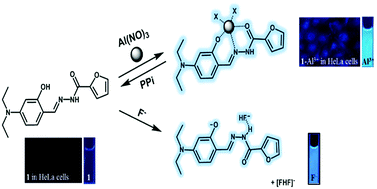Single fluorescent chemosensor for multiple targets: sequential detection of Al3+ and pyrophosphate and selective detection of F− in near-perfect aqueous solution†
Abstract
A simple and easily fabricated chemosensor (1), based on 2-furoic hydrazide and diethylaminosalicylaldehyde moieties, was devised and synthesized. Sensor 1 showed selective changes in fluorescence behavior toward three analytes in near-perfect aqueous solution. Al3+ and F− recognized by fluorescence enhancement of 1 and their limits of detection (0.19 μM for Al3+ and 1.9 μM for F−) were markedly low compared to World Health Organization guidelines (7.4 μM for Al3+ and 79 μM for F−) for drinking water. Furthermore, sensor 1 was used to quantify Al3+ and F− in real water samples and image Al3+ in living cells. Interestingly, the resulting 1–Al3+ complex could be used to discriminate pyrophosphate (PPi) over competing anions, including phosphate-based anions, by decreased fluorescence. Sensing mechanisms of 1 toward Al3+, PPi, and F− were proposed based on photophysical studies and theoretical calculations.



 Please wait while we load your content...
Please wait while we load your content...